Efficient heating scheme of a two-story house using a gas or
When building a private dwelling house, one of the most important tasks that needs to be solved at the construction design stage is competent organization of an autonomous heating system. The fact is that not only the level of comfortable living in a house during the cold season, but also the amount of annual financial expenses that will need to be paid for the purchase of fuel for boiler equipment, will depend on the correct solution of this issue.
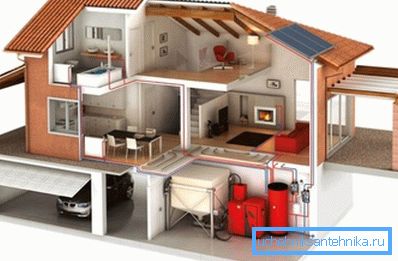
Development of a water heating system
If you can use a conventional stone or brick stove to heat a small one-story private house, then different heating schemes for a two-story house using gas or solid fuel heating boilers are more effective for heating large houses and cottages.
In order to study this issue in more detail, this article will provide a brief overview instruction, which examines the most common heating schemes for a two-story house using radiator heating and floor heating systems. (See also the article Pipe for floor heating: features.)
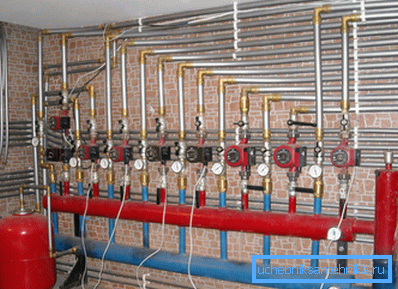
The main components of the heating system
Regardless of which layout was chosen for heating a two-story house, any such system includes a set of the following components and mechanisms that are necessary to ensure its uninterrupted operation:
- Boiler It can operate on liquid, solid or gaseous fuels, and serves to heat water or other heat carrier to a certain operating temperature.
- Heating radiators, in fact, they are ordinary heat exchangers in which heat from the heated water is transferred through the ribbed metal walls to the cold ambient air.
- As a rule, each scheme of radiator heating of a two-story house includes two interconnected water pipes.. The contour of the direct pipeline serves to transport the heated coolant from the boiler to the final heater, i.e. the radiator installed in each room, and the return contour serves to return the cooled coolant back to the boiler.
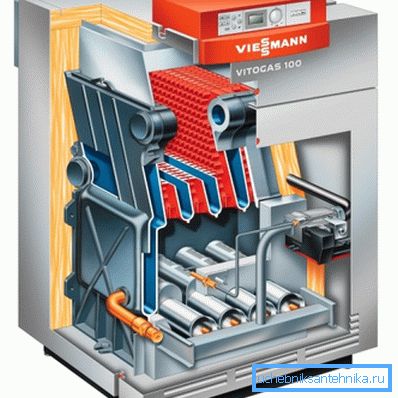
- Expansion tank serves to smooth the pressure drops in the system, and compensate for the volume of coolant. When the working fluid is heated, it increases in volume, with the result that its surplus falls into the sealed chamber of the expansion tank. As a result of cooling, reducing pressure and reducing the volume of liquid, the coolant under the action of the spring-loaded diaphragm returns back to the system.
- Circulation pump provides a constant movement of the working fluid through the pipeline in a given direction, and maintains a given working pressure of water in the system.
- Among other things, any heating scheme of a two-story private house contains all sorts of elements of valves and control valves.: ball valves, safety and check valves, mechanical thermostats, as well as connecting fittings and fasteners.
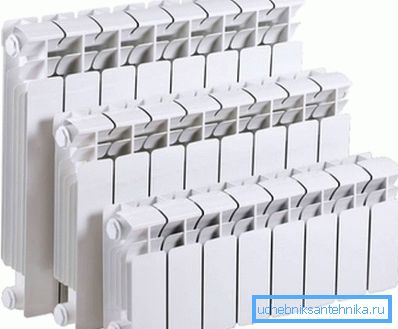
Tip! In houses of seasonal residence, as a heat carrier, instead of water it is recommended to use a special low-temperature liquid or antifreeze. Its price is significantly higher than the cost of ordinary water, but it does not freeze at low temperatures, and also has anti-corrosion properties.
Single pipe connection
The simplest, but at the same time, least efficient is the one-pipe scheme of the heating system of a two-story house, which is a chain of heating radiators installed in different rooms that are sequentially interconnected by means of metal or plastic water pipes.
This type of connection allows you to minimize the amount of materials used and work performed, however, it also has some significant drawbacks.
- The heated water, passing through pipes and radiators, gives off its heat unevenly, and as it moves to the remote rooms of the house, it gradually cools.
- To compensate for this phenomenon, in order to increase the heat transfer area, it is required to install a larger number of water radiators in remote rooms.
- With this connection option, it becomes impossible to adjust the optimum temperature for each individual room in a residential building with your own hands.

Using a two-pipe circuit
More efficient, but at the same time more expensive is the two-pipe water heating scheme of a two-story house, the installation of which requires the consumption of a larger amount of materials and labor costs.
With this connection, each water radiator separately, the inlet pipe is connected to the direct heating circuit, and the outlet pipe - to the reverse circuit of the heating system.
For two-storey houses, this connection option is considered the most optimal, since it has the following advantages:
- Due to the uniform heat transfer, the same heating of all rooms of a residential house is ensured, regardless of their relative position relative to the heating boiler.
- Separate connection of each section makes it possible to independently regulate the required temperature for each specific room or room of a residential building.
- More efficient distribution of heat leads to an increase in the energy efficiency of the entire system and, consequently, to significant fuel savings.
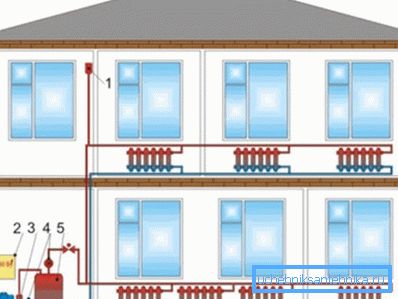
Note! Among other things, such a connection allows removing direct and return pipelines from outside eyes by placing them under a clean floor, or behind elements of decorative wall decorations.
Distribution of pipes according to the combined scheme
In the design and construction of a residential house with a system of underfloor heating, the most rational will be the combined heating scheme of a private two-story house, which combines both one-pipe and two-pipe connection.
In this case, parallel to the direct and return pipelines, a separate collector for heat carrier is connected via a three-way valve, to which a system of warm water floor is successively connected.
Such a connection has all the advantages of a two-pipe scheme, and in addition allows separately to include heating radiators and a heated floor system, which makes it possible to more flexibly regulate the required temperature in the room.
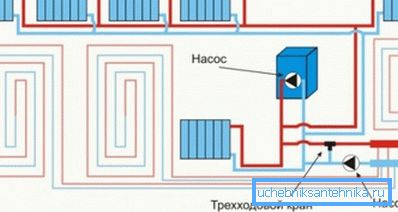
Tip! In parallel to the collectors of the underfloor heating system, you can also connect heated towel rails located in the bathroom, shower or in the kitchen.
Conclusion
Regardless of which scheme was chosen, the heating of a two-story house is an important object of the internal infrastructure, and such work must be approached with knowledge, since gross design or installation errors can be eliminated only in the warm season.
All the necessary information can also be obtained by watching the video at the end of this article, or by reading similar materials on our website.